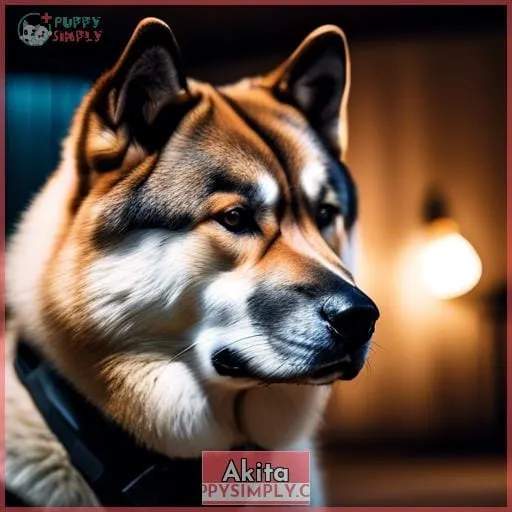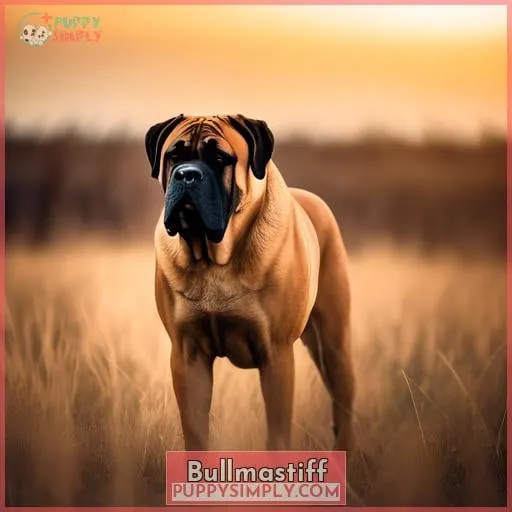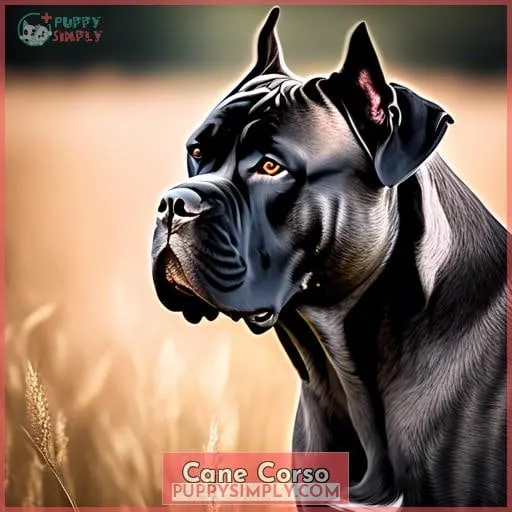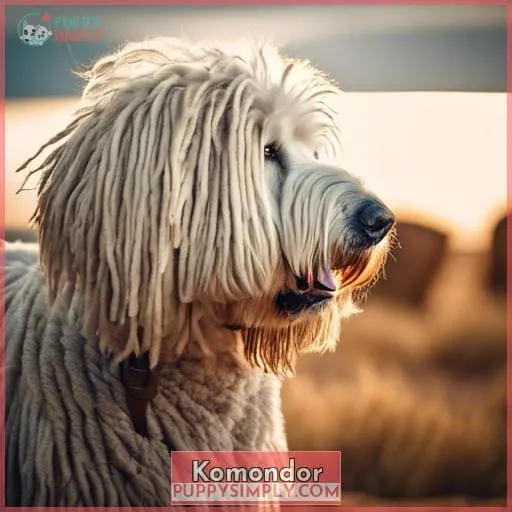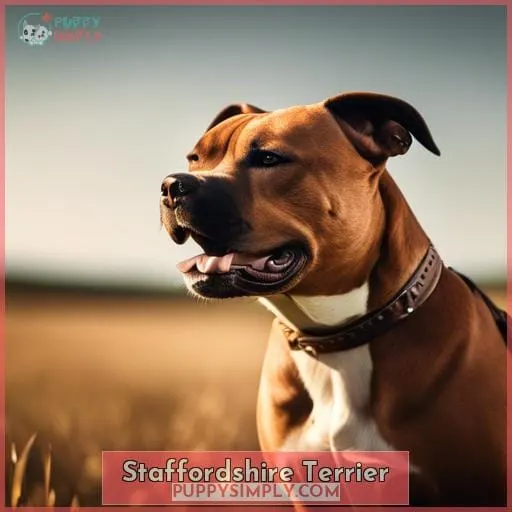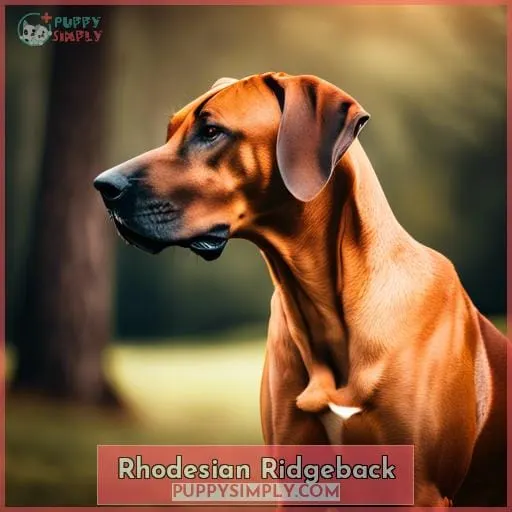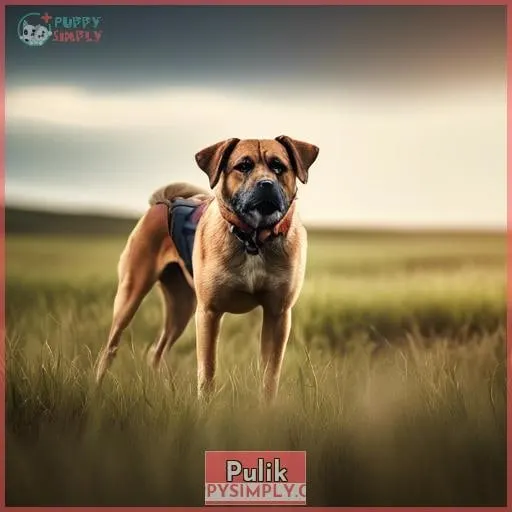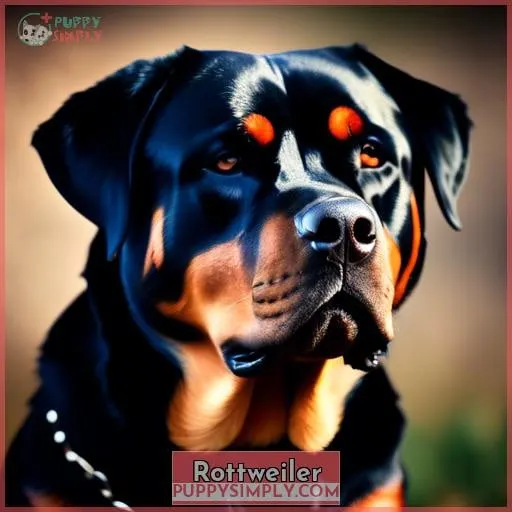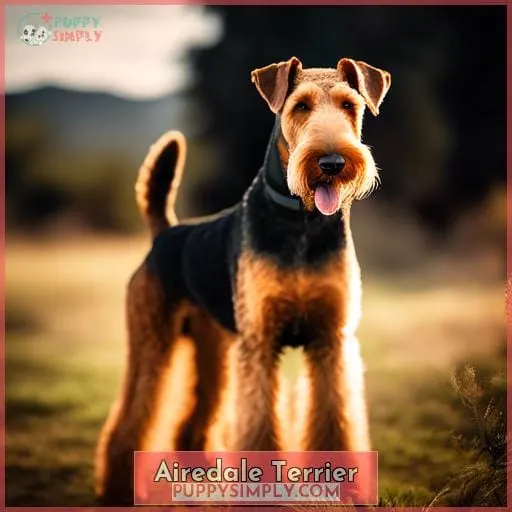This site is supported by our readers. We may earn a commission, at no cost to you, if you purchase through links.
 Ever wondered which dog breeds make the best guardians?
Ever wondered which dog breeds make the best guardians?
With their fierce protectiveness and alert natures, certain dogs have the traits needed to keep your home safe.
As you look for a canine defender, remember: a good guard dog is fearless yet obedient, strong yet gentle.
Train properly, and your loyal companion will watch over you while deterring danger.
Among the top options are intelligent, energetic breeds who will vigorously secure your property without being needlessly aggressive.
Ready to find your family’s steadfast sentinel?
Here are the 10 finest guard dogs to shield your home.
Table Of Contents
- Key Takeaways
- Akita
- Belgian Malinois
- Bullmastiff
- Cane Corso
- Komondor
- Staffordshire Terrier
- Rhodesian Ridgeback
- Pulik
- Rottweiler
- Airedale Terrier
- Frequently Asked Questions (FAQs)
- What are the pros and cons of small guard dogs versus large guard dogs?
- How much daily exercise and stimulation does each breed need?
- What health issues or genetic conditions are common in certain breeds?
- How do you properly socialize a guard dog with children, strangers, and other pets?
- What’s the ideal living situation and environment for each breed – apartments, big yards, hot/cold weather, etc.?
- Conclusion
Key Takeaways
- Akita, Bullmastiff, Cane Corso, and Komondor are all protective and loyal guardians.
- Belgian Malinois and Komondor are athletic and energetic working dogs.
- Akita, Bullmastiff, Cane Corso, and Komondor have distinctive physical characteristics.
- Akita, Belgian Malinois, Bullmastiff, Cane Corso, and Komondor all have unique temperaments and behaviors.
Akita
You’ll want to know the Akita’s history as a protector of Japanese royalty and its temperament as a naturally suspicious and protective family dog.
Proper socialization and obedience training are musts for this large, strong breed that can stand 24-28 inches tall and weigh 70-130 pounds.
With the right upbringing, the courageous Akita can be a loyal guardian and affectionate companion.
Origin and History
Initially bred to protect royalty in feudal Japan, the Akita is a large dog with a naturally suspicious and protective temperament.
Loyal guardians since ancient Mesopotamia.
Descended from Mastiff-type dogs that protected livestock and property.
Bred in isolation, developing fierce independence and protectiveness.
Used for hunting, guarding, and protecting farming communities.
Temperament and Training Needs
Naturally protective and suspicious of strangers, you should train your Akita to see you as the pack leader who sets ground rules for behavior.
Socialization, practicality, and patience are key.
With proper motivation, consistency, understanding, and setting clear boundaries, your Akita can be a loyal protector.
Reward good behavior.
Correct unwanted actions firmly but calmly.
Exercise and stimulation are also critical for this energetic breed.
Size and Physical Characteristics
The Akita has a large, sturdy frame with a dense double-coat to withstand cold weather.
The Akita’s build tends heavily toward dense bone structure and powerful musculature.
This breed’s broad head, deep chest, and curled tail give it a primitive appearance that imparts strength and hardiness.
The thick undercoat and harsh outer coat enable the Akita to tolerate frigid temperatures.
With proper care, the sturdy and rugged Akita enjoys excellent health into old age.
Belgian Malinois
Coming from the revered Akita, you’ll find the Belgian Malinois is the preferred breed for police and military K-9 units.
This is thanks to its intense athleticism, work ethic, and need for specialized training.
This energetic breed thrives when given a job to do, whether it’s police work, herding, or guarding.
To keep a Malinois happy and focused:
- Provide at least 2 hours of vigorous exercise daily.
- Practice obedience training and mental stimulation games.
- Invest in grooming tools to manage their thick, shedding coat.
- Properly socialize them as a puppy to curb overprotective tendencies.
With the right handling, training, and outlets for their energy, the Malinois makes an alert, obedient, and devoted protection dog.
Their strong work drive and bravery allow them to confront threats fearlessly while bonding closely to their family.
Bullmastiff
Your Bullmastiff’s intimidating size and appearance belie a gentle, family-oriented temperament that makes them ideal guardians.
Though initially developed to protect game from poachers, this breed’s natural affection towards family makes them wonderful pets.
Their large, imposing build is complemented by a loyal, brave spirit that bonds strongly with owners.
Some obedience training can reinforce their instincts to be an excellent guard dog.
Regular grooming maintains their short coat while meeting exercise requirements prevents boredom.
Training should strike a balance between protection and aggression as their sheer size means they can easily knock over small children.
But with proper socialization and structure, the Bullmastiff’s devotion and alertness strike an ideal balance for guarding your home.
Cane Corso
The Bullmastiff may be large and intimidating, but the Cane Corso takes protection to the next level.
Historically used in Italy as catch dogs, hunters, and guardians, the Cane Corso possesses an innate protective instinct that makes them ideal home and family guard dogs.
Though naturally cautious with strangers, with proper socialization and training, this large, muscular breed is attentive, obedient, and devoted to their family.
Their short, stiff coat requires minimal grooming.
Despite their imposing presence, the Cane Corso has a calm and dignified demeanor.
Responsive and alert, they’re always ready to spring into action to defend their territory.
Provide your Cane Corso with daily mental and physical exercise to prevent boredom.
With strong prey drive, supervision around small pets is recommended.
For an intimidating yet loving guard dog, the Cane Corso can’t be beat.
Komondor
How does the Komondor make for an excellent guard dog?
This Hungarian breed’s unique mop-like textured coat serves as natural armor, while its large size and muscular build make it an imposing figure.
Though renowned for herding instincts, Komondors possess a protective nature that transitions well into guarding.
Their fur requires extensive grooming – separating the cords by hand to avoid matting.
Failing to properly maintain their coat can lead to skin irritation and infection.
Despite their rugged exterior, Komondors thrive on attention and affection from their family.
Their loyalty and desire to please make training them rewarding.
While not for novice owners, Komondors’ fearless guarding abilities endear them to those seeking unwavering protection.
With patience and proper socialization, they can become sweet home guardians who alert owners to any perceived threats.
Staffordshire Terrier
You’ll adore the Staffordshire Terrier’s magnetic personality.
Originally bred in England’s Staffordshire county for bull baiting, they excel at obedience, agility, and conformation shows today.
Don’t be fooled by media misconceptions – proper socialization and training cultivate their gentleness.
These medium-sized, muscular pups thrive when challenged mentally and physically.
Their affectionate, people-oriented temperament suits active owners able to provide consistent leadership.
Compared to demanding guarding breeds, Staffies are easier to handle than Belgian Malinois but more energetic than Basset Hounds.
With appropriate outlets for their enthusiasm, they can make wonderful companions like Labrador Retrievers, Golden Retrievers, or Irish Setters.
Rhodesian Ridgeback
Six fearless guard dogs hail from Rhodesia, South Africa.
They were bred to fight lions with their muscular 70-85 pound frames spanning 25-30 inches tall.
Originally used for hunting, their stamina and agility make them well-suited to running down prey across long distances.
The distinctive ridge along their backs likely comes from crossbreeding with ridged hunting dogs brought to the region by Dutch colonists.
As their name suggests, Rhodesian Ridgebacks tolerate hot climates well.
While long considered a rare novelty pet, their popularity has grown over recent decades.
Before bringing one of these powerful dogs home, make sure you can provide:
- Vigorous daily exercise
- Confident leadership
- Socialization
- Integrated training
Responsible ownership of any guard dog entails providing preventative veterinary care like:
- Vaccines
- Heartworm prevention
- Flea/tick control
Wellness plans can make budgeting for annual exams, recommended testing, and even spay/neuter surgeries more manageable.
Pulik
Coming from the noble Rhodesian Ridgeback, known for its lion hunting skills, we have the energetic Pulik.
Though smaller, the Pulik makes up for its size with intelligence and alertness, making it an ideal guard dog. Its weather-resistant coat enables it to be outside for extended periods, keeping watch over your property.
Puliks will bark to alert you of any intruders, but their energetic and mischievous nature means they need attentive owners who can provide plenty of exercise and an outlet for their enthusiasm. With appropriate levels of activity and stimulation, Puliks focus their abilities, displaying their loyalty and protectiveness.
Do dedicate time to thoroughly brushing their unique cords to prevent matting.
Overall, Puliks nicely balance intelligence, alertness, and endurance in a medium-sized package that excels at guarding.
Rottweiler
Having examined the alert and energetic Pulik, you’ll now find the proven guarding abilities of the Rottweiler from Germany.
With their large size ranging from 90 to 120 pounds and 22 to 28 inches tall, Rottweilers make ideal guard dogs that provide physical protection thanks to their strong and muscular build.
Their energy level is medium to high, so daily exercise is a must. Their short coat requires minimal grooming, just occasional brushing.
Potential health issues include hip and elbow dysplasia. With a lifespan of 8 to 13 years, their proven abilities as guard and police dogs make them a popular choice to protect your home and family.
Rottweilers are obedient and receptive to training, allowing you to hone their natural protective instincts. Their size and strength intimidate intruders, while their affectionate nature makes them wonderful companions.
Rottweilers require proper socialization but, with the right training, exhibit unwavering loyalty.
Airedale Terrier
After discussing the Rottweiler’s proven guarding abilities in Germany,
you’ll find that the Airedale Terrier’s friendly and enthusiastic temperament makes it an excellent family dog that protects with persistent barking rather than aggression.
The Airedale excels at quarry hunting and is eager to please, making training relatively easy.
Its loud, deep bark alerts owners to any unusual sights or sounds.
However, its vociferous barking may disturb neighbors.
The Airedale’s medium-length coat requires regular brushing and clipping.
While generally healthy, vet costs may rise due to allergies or hip dysplasia.
Before adopting an Airedale, consider your lifestyle match, grooming commitment, and training dedication to bring out this breed’s best qualities.
Frequently Asked Questions (FAQs)
What are the pros and cons of small guard dogs versus large guard dogs?
Small breeds offer ease of handling but lack intimidation.
Large breeds provide imposing protection yet require more space, exercise, training, and control.
Choose based on your lifestyle and needs, then properly socialize and train.
How much daily exercise and stimulation does each breed need?
For a strong, healthy life, join your loyal protector on daily outings.
Give each breed the attention and activity it craves, whether an hour-long hike with your tireless Malinois or short jaunts around the block with your sturdy Bullmastiff.
Their devotion blossoms through shared adventures.
What health issues or genetic conditions are common in certain breeds?
Consider hip dysplasia in Rottweilers and mastiff breeds.
Akitas are prone to eye issues.
Monitor Rhodesian Ridgebacks for dermoid sinus.
Provide early socialization for breeds like Dobermans and German Shepherds to prevent aggression.
How do you properly socialize a guard dog with children, strangers, and other pets?
Socialization is key for any pup.
Expose them early; a dog is man’s best friend, not foe.
Introduce children, strangers, and pets calmly and reward good behavior.
Stay consistent, set boundaries, but show love.
A well-socialized guard dog brings safety, not anxiety.
What’s the ideal living situation and environment for each breed – apartments, big yards, hot/cold weather, etc.?
Train each breed according to its instincts.
Akitas and Tibetan Mastiffs need space and patience.
Terriers thrive with activity and discipline.
Give protective breeds proper socialization to temper their caution around strangers.
Match the environment to the breed’s abilities for everyone’s happiness.
Conclusion
You’re in great paws with any of these steadfast breeds!
Though no dog is infallible, these intelligent, energetic guardians have the traits to vigorously secure your home.
With proper socialization and training, a loyal canine companion from this group will be your family’s rock-solid sentinel.
Their alert natures and protectiveness make these the finest guard dogs to shield your castle.
Invest time with your new best friend, and you’ll have a fearless yet gentle guardian.

